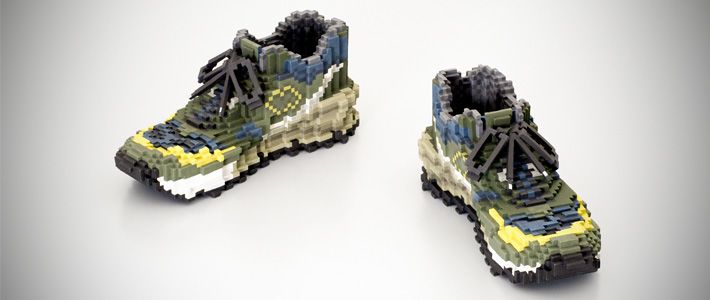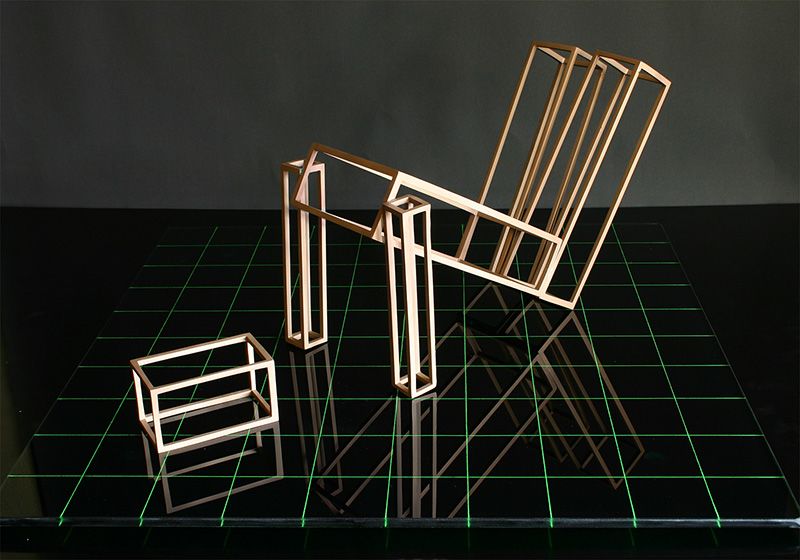
“Cool Traditions” Stay in Tune with Modern Life
Digitally Mastered: The Ceramic Artwork of Masuda Toshiya
Culture- English
- 日本語
- 简体字
- 繁體字
- Français
- Español
- العربية
- Русский
Natural Artefacts
Masuda Toshiya came of age surrounded by the sights and sounds of the modern Japanese urban environment. “Having grown up in Osaka, my world was awash in man-made images,” he explains. “I never thought of untouched natural scenery as the original state of my surroundings. Scenes from video games and the like were the landscape of my childhood.”
Taking inspiration from these images, Masuda today uses traditional techniques to create works of ceramic art that he describes as “digital visual.”
 Masuda Toshiya
Masuda Toshiya
Born in Osaka in 1977. Earned his crafts degree from the Osaka University of Arts. In 2005 was awarded a special jurors prize at the seventh International Ceramics Competition, Mino, Gifu Prefecture. Has displayed his works at exhibitions in Japan and abroad.
Masuda’s interest in creating art began when he was a child. He attended Osaka Kōgei Kōkō, a high school offering courses in industrial arts, and then went on to study metalwork at the Osaka University of Arts. As a student he admits to being overly concerned about the artistic quality of his creations, a situation he says hampered his work. However, inspiration finally came after he took an assistant position at his university. While involved in a project forming metal cylinders into lattice shapes, he stumbled across ceramic art while searching for an effective way to express his digitally inspired structures.
“It became obvious that clay was far better suited than metals for what I wanted to do,” says Matsuda. To make his lattice-shaped creations he turned to molding works from slabs of clay, a method known as tatara.
 One of Masuda’s metalwork pieces. (© Masuda Toshiya)
One of Masuda’s metalwork pieces. (© Masuda Toshiya)
Warmly Pixelated
From 2003 to 2006 he crafted his first series of pieces, the industrial truck-themed Anachro CG. The gridlike, three-dimensional quality of these early works are almost toylike in appearance.
 Fork Lift from the Anachro CG series. Masuda used various methods in forming the slabs of clay, including slicing, bending, and stacking. (© Masuda Toshiya)
Fork Lift from the Anachro CG series. Masuda used various methods in forming the slabs of clay, including slicing, bending, and stacking. (© Masuda Toshiya)
In his next series, Low Pixel CG, Masuda looked to engage people on a new level by creating life-size works based on the low-grade graphics of early video games.
“I chose objects that have a latent power to tell a story. For example, we hardly bat an eye when we see fire extinguishers standing in hallways and other places. However, if we come across one laying on its side we immediately try to piece together a narrative of what happened. Faced with the grainy quality of the Low Pixel series, viewers look to their own experiences and takes on the world to explain what they are seeing. Pixelated images are largely unremarkable, but my works show they can trigger surprising emotions.”
 Fire Extinguisher? from the series Low Pixel CG. (© Masuda Toshiya)
Fire Extinguisher? from the series Low Pixel CG. (© Masuda Toshiya)
Despite the digital theme of his works, Masuda creates his pieces by hand. First he draws outlines on heavy drafting paper and then cuts these out to form serrated models that serve as patterns for each layer of clay. Watching him handle the slabs of earth brings to mind the careful movements of a confectioner, a comparison the artist wryly welcomes by quipping that the ideal clay has the same consistency of a thick ganache.
Once the sections are formed Masuda assembles them using a clay-based solution known as dobe, creating an artifact that looks more like a topographical image than artwork. Masuda refrains from applying a glossy glaze to his works, preferring an unrefined finish. As his final step, he applies various shades of underglaze he sources from the United States, giving the pieces a matte finish and bestowing them with a sense of digital familiarity.
 The different steps involved in creating the work Manekineko (beckoning cat). (© Masuda Toshiya)
The different steps involved in creating the work Manekineko (beckoning cat). (© Masuda Toshiya)
Masuda says that pixelated imagery has a way to connect with people that other visual technologies do not. “Computer graphics have become amazingly real, but conversely it’s become nearly impossible get a sense of the type of person who created the images. The great thing about pixel art is the limitations it places on creative work. Faced with these restrictions, creators must carefully consider how best to portray each object. This gives digital images an endearing, hand-crafted appeal that generates a sense of nostalgia for people of all generations, not just those who grew up playing video games.”
 Clockwise from upper left: Masuda carefully applies underglaze; cutting a clay piece to shape; works in progress sit on a shelf in Masuda’s workshop.
Clockwise from upper left: Masuda carefully applies underglaze; cutting a clay piece to shape; works in progress sit on a shelf in Masuda’s workshop.
Bringing Context to Ceramic Art
Masuda used such famous styles of pottery as Nara-sansai and Shinoyaki as motifs for his Pop Icon series, a collection that explores the veneration of ceramic pieces.
“The more I study pottery the more I come to question the established norms of the form,” Masuda explains. In particular, he sees incongruity in the tendency to exalt well-known works. “It is strange to me that once a piece is recognized as an important cultural property or national treasure it is treated solely as a work of art and displayed in a thick, protective glass case.”
 Narumi from the Pop Icon series is based on handled pottery in the Narumi-oribe style. (© Masuda Toshiya)
Narumi from the Pop Icon series is based on handled pottery in the Narumi-oribe style. (© Masuda Toshiya)
To explore this odd practice of exalting items originally designed as utensils and sealing them behind a sheet of glass, Masuda displayed each piece in the series in an acrylic case.
While Masuda has deep respect for the traditional ceramic arts, he asserts the importance of questioning the status quo. “So much of art is about challenging hierarchies and authority. However, with the current absence of anything that can be considered ‘mainstream art,’ this has become less pronounced. Artists are now focusing their alternative energies on narrowly chosen themes. Pottery, on the other hand, has a widely accepted image and culture, and while it is not my goal to belittle the form, I feel it is important to create works that express my apprehension about conventional assumptions.”
Equipped with his ideas and techniques, Masuda looks to take ceramic art into new, unexplored realms. “I want to further pursue how pottery is visually represented,” he explains, “by studying the works of Chris Cunningham and other video art creators.” It remains to be seen where Masuda’s musings will take him next, but he is one young Japanese artist worth watching.
(Originally published in Japanese on March 22, 2017. Interview and text by Kiyabu Ai. Photos © Ōshima Takuya except where otherwise indicated. Banner photo: Low Pixel CG from the series Selfportrait. © Masuda Toshiya.)